Royal Thai Navy
The Royal Thai Navy (Abrv: RTN, ทร.; Thai: กองทัพเรือไทย, RTGS: kong thap ruea thai), Thailand's naval warfare force, was established in 1906. It was modernised by the Admiral Prince Abhakara Kiartiwongse (1880–1923) who is known as the father of the Royal Navy. It has a structure that includes the naval fleet, Royal Thai Marine Corps, and Air and Coastal Defence Command. The RTN headquarters is at Sattahip Naval Base.
| Royal Thai Navy | |
|---|---|
| กองทัพเรือ | |
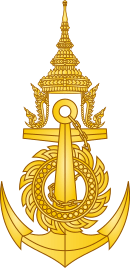 Emblem of the Royal Thai Navy | |
| Founded | 20 November 1906 (113 years) |
| Country | Thailand |
| Branch | Royal Thai Marine Corps Air and Coastal Defence Command |
| Type | Navy |
| Role | Naval warfare |
| Size | 69,850 Active personnel[1] |
| Part of | Royal Thai Armed Forces |
| Garrison/HQ | Sattahip Naval Base (Main base), Sattahip, Chonburi Bangkok Noi, Bangkok (Headquarters) |
| Nickname(s) | ราชนาวี ('Raj Navy') |
| Motto(s) | ร่วมเครือนาวี จักยลปฐพีไพศาล ('Join the Navy to see the world') |
| Colours | Navy blue |
| March | เพลงราชนาวี ('Navy March') เพลงดอกประดู่ ('Dok Pradu Song') |
| Engagements |
|
| Website | RTN |
| Commanders | |
| Commander-in-chief | Admiral Luechai Rutdit |
| Notable commanders | King Pin-Klao Prince Abhakara Kiartivongse Sangad Chaloryu Sathiraphan Keyanon |
| Insignia | |
| Flag | 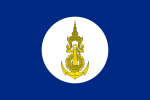 |
| Naval jack and unit colour | 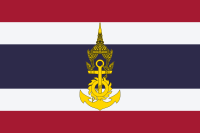 |
| Naval ensign |  |
| Fin flash | 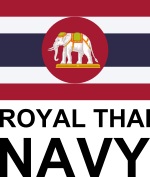 |
The navy operates three naval area commands (NAC): Northern Gulf of Thailand (First NAC); Southern Gulf of Thailand (Second NAC); and the Andaman Sea (Indian Ocean) (Third NAC). RTN also has two air wings and one flying unit on its aircraft carrier.
Budget
In fiscal year 2019 (FY2019) the navy's budget was 45,485 million baht.[2] In FY2020, its budget is projected to be 47,300 million baht.[3]
History
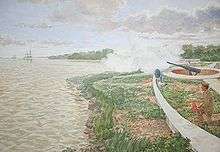
Ancient era
The military history of Thailand encompasses 1,000 years of armed struggle, from wars of independence from the Khmer Empire through to struggles with her regional rivals, Burma and Vietnam, and periods of conflict with Britain and France during the colonial era.[4]
The naval arm of the army consisted mainly of riverine war craft whose mission was to control the Chao Phraya River and protect ships carrying the army to battle. The warships carried up to 30 musketeers and 6- or 12-pounder cannons.
Vietnamese - Siamese war
The timeline of emergence of a Siamese sea fleet is unknown. Most of its sailors were foreign, such as Cham, Malay, and Chinese. It is assumed that in this era, Ships designs changed from shallow draft Chinese junk (Reu-Sam-Pau/Reụ̄x s̄ảp̣heā) to deeper draft Kam-pan and sloop; with a short period of copied Vietnamese junks. The most prominent naval battle was at Vàm Nao River.
Franco-Siamese War
The Paknam Incident was a navy engagement fought during the Franco-Siamese War in July 1893. Three French ships violated Siamese territory and warning shots were fired at them by a Siamese fort and a force of gunboats on the Chao Phraya River in Paknam.[5]:259 In the ensuing battle, France prevailed and blockaded Bangkok.[5]:263 Peace was restored on 3 October 1893 after the British put pressure on both the Siamese and French to reach a negotiated settlement.[6]:127
World War I
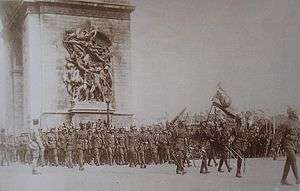
The First World War had no direct impact on Siam due to its distance from the fighting. The war did, however, provide an opportunity for King Rama VI to strengthen his country's position in the international arena. He also used the war as a means to promote the concept of a Siamese nation.[4][7]
Siamese sailors were part of a volunteer expeditionary force, consisting of medical, motor transport, and aviation detachments.[8] By early-1918, 1,284 men were selected from thousands of volunteers. The force was commanded by Major General Phraya Bhijai Janriddhi and was sent to France.[9]
After World War I
Franco-Thai War
The Battle of Ko Chang took place on 17 January 1941 during the Franco-Thai War in which a flotilla of French warships attacked a smaller force of Thai vessels, including a coastal defence ship.[10] The HTMS Thonburi was heavily damaged and grounded on a sand bar at the mouth of the Chanthaburi River, with about 20 dead. The Thai transport HTMS Chang arrived at Ko Chang shortly after the French departed and took the Thonburi in tow, before purposefully running her aground in Laem Ngop.
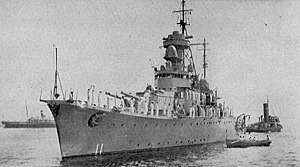
The French suffered 11 men killed. During the post-action investigations, the Thai Navy claimed, based on statements by Thai sailors and the fisherman around Ko Chang and merchantmen in Saigon, that heavy damage was seen to have been caused to the French ship Lamotte-Picquet and her squadron. The battle was a tactical victory by the French Navy over the Thai Navy although the strategic result is disputed. The Japanese intervened diplomatically and mediated a ceasefire.[11] Within a month of the engagement, the French and the Thais had negotiated a peace that ended the war.
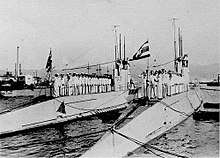
World War II
During World War II, Siam allied with Japan after Japan invaded Siam on 8 December 1941.[12] Thailand officially joined the war in January 1942.
Thai submarines saw service throughout World War II, but saw no combat. Two of them did serve an unconventional role during the war. On 14 April 1945, five months before the Japanese surrender, Bangkok's Samsen and Wat Liab Power Plants were bombed by the Allies, leaving the city without electricity. In response to a request from the Bangkok Electricity Authority, the Matchanu and Wirun anchored at the Bangkok Dock Company and served as power generators for one of Bangkok's tram lines.[14]
Manhattan Rebellion
During the Manhattan Rebellion of 1951, the navy was involved in a failed coup against Prime Minister Plaek Phibunsongkhram which led to the sinking of flagship HTMS Sri Ayudhya.[15]
Vietnam War
In support of South Vietnam and its allies during the Vietnam War, two Thai naval vessels supported ground forces with naval bombardments.[16]
Present day
The navy's combat forces include the Royal Fleet and the Royal Thai Marine Corps. The 130 vessels of the Royal Fleet include frigates equipped with surface-to-air missiles, fast attack craft armed with surface-to-surface missiles, large coastal patrol craft, coastal minelayers, coastal minesweepers, landing craft, and training ships.
The mission space of the Thailand navy includes the Gulf of Thailand and the Indian Ocean, which are separated by land, as well as rivers. Naval affairs are directed by the country's most senior admiral from his Bangkok headquarters. The naval commander in chief is supported by staff groups that plan and administer such activities as logistics, education and training, and various special services. The headquarters general staff functioned like those of corresponding staffs in the army and air force command structures.
Command and control
The Royal Thai Navy is commanded by the Commander-in-Chief of the Royal Thai Navy, currently, Admiral Luechai Rutdit, who was appointed in 2018. The Royal Thai Navy headquarters is in Bangkok.
- Commander-in-Chief, Royal Thai Navy: Admiral Luechai Rutdit
- Deputy Commander-in-Chief, Royal Thai Navy: Admiral Chorchat Gra-tes
- President, Royal Thai Navy Advisory Group: Admiral Somchai Na Bangchang
- Assistant Commander-in-Chief, Royal Thai Navy: Admiral Chatchai Srivorakan
- Chief of Staff, Royal Thai Navy: Admiral Sittiporn Maskasem
- Commander-in-Chief, Royal Thai Fleet: Admiral Chumsak Nakvijit
Organisation
Naval Area Commands
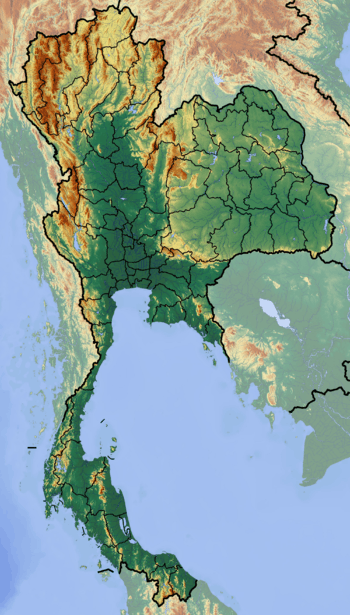
The Royal Thai Navy operates three naval area commands:
- First Naval Area Command: responsible for the northern part of Gulf of Thailand
- Second Naval Area Command: responsible for the southern part of Gulf of Thailand
- Third Naval Area Command: responsible for the Andaman Sea (Indian Ocean)
District forces
- Navy Fleet District Forces
- Northern Gulf of Thailand Fleet
- Southern Gulf of Thailand Fleet
- Andaman Sea Fleet
- Royal Thai Naval Air District Forces
- U-Tapao Royal Thai Navy Airfield
- Chanthaburi Airstrip
- Nakhon Phanom Royal Thai Navy Base
- Songkhla Royal Thai Navy Airfield
- Phuket Royal Thai Navy Airfield
- Narathiwat Airstrip
- Navy Bases District Forces
- Sattahip Naval Base
- Bangkok Naval Base
- Phang Nga Naval Base
- Songkhla Naval Base
- Phuket Naval Base
- Samui Naval Base
- Trat Naval Base
Organization
| Naval Headquarters | Naval Fleet | Naval Logistics Support Group | Naval Education, Research and Development Group |
|
|
|
|
Royal Thai Naval Dockyard

The Naval Dockyard is in Bangkok Noi District, Bangkok. It has constructed and repaired ships since the reign of King Mongkut. As ships grew larger, King Chulalongkorn ordered the construction of a large wooden dock. He presided over the opening ceremony on 9 January 1890, a date now considered the birth of the Naval Department. Its headquarters is now at Mahidol Adulyadej Dockyard, Sattahip District, Chonburi Province.
- Ships built during the reign of King Rama VIII, Ananda Mahidol:
- Ships built during the reign of King Rama IX, King Bhumibol Adulyadej the Great:
- HTMS Khamronsin (II)-class: Corvette; displacement 450 tons; three ships in this class[17]
- HTMS Hua Hin-class: Patrol gunboat; displacement 530 tons; three ships in this class[17]
- HTMS Sattahip (I)-class: Torpedo boat; displacement 110 tons[17]
- Tor.91-class: Patrol Boat: displacement 115 tons; nine ships in this class[17]
- Thor (II)-class: Minesweeper; displacement 29.56 tons; five ships in this class[17]
- HTMS Proet: Tanker; displacement 412 tons; two ships in this class[17]
- HTMS Chuang-class: Water tanker; displacement 360 tons; two ships in this class[17]
- HTMS Samaesarn (II)-class: Tugboat; displacement 328 tons; two ships in this class[17]
- Tor.991-class: Gunboat; displacement 115 tons; four ships in this class[17]
- HTMS Krabi-class: Offshore patrol vessel; displacement 1,969 tons; two ships in this class[17]
- HTMS Laemsing-class: Patrol gunboat; displacement 520 tons[17]
Royal Thai Marine Corps
The Royal Thai Marine Corps (RTMC) was founded in 1932, when the first battalion was formed with the assistance of the United States Marine Corps. It was expanded to a regiment in 1940 and was in action against communist guerrillas throughout the 1950s and 1960s. During the 1960s, the United States Marine Corps assisted in its expansion into a brigade. In December 1978, RECON teams of The Royal Thai Marine Corps were sent to the Mekong River during skirmishes with the Pathet Lao, a communist political movement and organisation in Laos.[18]
_2013_at_Hat_Yao_130609-N-YU572-155.jpg)
Thai Marines today are responsible for border security in Chanthaburi and Trat provinces. They have fought communist insurgents in engagements at Baan Hard Lek, Baan Koat Sai, Baan Nhong Kok, Baan Kradook Chang, Baan Chumrark, and in the battle of Hard Don Nai in Nakhon Phanom Province. They serve in 2019 in the southern border provinces currently affected by the South Thailand insurgency. A monument to their valor stands at the Royal Thai Navy base at Sattahip.
Marine special force
The RTMC Reconnaissance Battalion, known as "RECON", is a reconnaissance battalion. It falls under the command of the Royal Thai Marine Division.[19][20] The mission of Reconnaissance Battalion is to provide task forces to conduct amphibious reconnaissance, ground reconnaissance, battlespace shaping operations, raids, and specialized insertion and extraction.[21][22]
Naval Special Warfare Command
.jpg)
The Naval Special Warfare Command was set up as an underwater demolition assault unit in 1956 with the assistance of the US.[23] A small element of the Navy SEALs has been trained to conduct maritime counter-terrorism missions. The unit has close ties with the United States Navy SEALs and conducts regular joint training exercises.
Most of the operations of the Navy SEALs are highly sensitive and are rarely divulged to the public. Navy SEALs have been used to gather intelligence along the Thai border during times of heightened tension.[18] Navy SEALs have participated in anti-piracy operations in the Gulf of Thailand.[18]
Thai Navy SEALs participated in the Tham Luang cave rescue. The rescue team successfully extricated members of 12 junior football players and their coach, who were trapped in Tham Luang Nang Non Cave in Chiang Rai Province in July 2018. One former Navy SEAL died in the rescue effort.[24]
Air and Coastal Defence Command
The Air and Coastal Defence Command was formed in 1992 under the control of the Royal Fleet Headquarters, with one coastal defence regiment and one air defence regiment. Personnel were initially drawn from the Royal Thai Marine Corps, but are now being recruited directly. The First Coastal Defence Regiment is based near the Marine Corps facility at Sattahip. The First Air Defence Regiment was near the Naval Air Wing at U-Tapao. Coastal Defence Command was greatly expanded in 1992, following the government's decision in 1988 to charge the RTN with the responsibility of defending the eastern seaboard and Southern Seaboard Development Project. The Second Air Defence Regiment, based at Songkhla, was formed the following year. Some analysts believe that this element will eventually grow to a strength of up to 15,000 personnel.[25]
- The First Air Defence Regiment: its mission is to provide anti-aircraft defence for the northern Gulf of Thailand with three anti-aircraft battalions.
- The Second Air Defence Regiment: to provide anti-aircraft defence for the southern Gulf of Thailand and Andaman Sea with three anti-aircraft battalions.
- The First Coastal Defence Regiment: has three artillery battalions.
- Two Air and Coastal Defence Command and Control Centers
- Air and Coastal Defence Supporting Regiment: one transportation battalion, one communications battalion, one maintenance battalion.
Royal Thai Naval Air Division
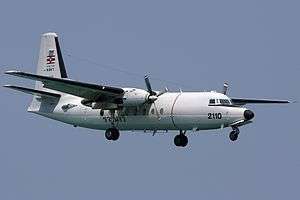
_in_the_Gulf_of_Thailand_conduct_an_in-flight_refueling_simulation_with_a_Thai_Navy_S-70B_Seahawk_helicopter_130608-N-AX577-323.jpg)
The RTN recently has two air wings and one Flying Unit of HTMS Chakri Naruebet, operating 23 fixed-wing aircraft and 26 helicopters from U-Tapao, Songkhla, and Phuket. The First Royal Thai Navy wing has three squadrons; the Second Royal Thai Navy wing has three squadrons and another wing for HTMS Chakri Naruebet Flying Unit.
| Squadron | Status | Role | Type | Aircraft | Number |
|---|---|---|---|---|---|
| The First Royal Thai Navy wing | |||||
| 101 | Active | SAR | Maritime patrol aircraft | Dornier 228 | 7[26] |
| 102 | Active | ASuW and ASW | Maritime patrol aircraft | Fokker27-MK 200 | 2[26] |
| 103 | Active | Forward air control | Maritime patrol aircraft | Cessna 337 Super Skymaster | 9 |
| 104 | Inactive | ||||
| The Second Royal Thai Navy wing | |||||
| 201 | Active | Military transport | Maritime patrol aircraft | Fokker27-MK 400 Embraer ERJ-135LR |
2[26] |
| 202 | Active | Military transport | Helicopter | Bell 212 H145M |
7[26] |
| 203 | Active | ASuW and Military transport | Helicopter | SH-76B Seahawk Super Lynx 300 |
4[26] |
| HTMS Chakri Naruebet Flying Unit | |||||
| 1 | Inactive | ||||
| 2 | Active | ASW and Military transport | Helicopter | SH-70B Seahawk MH-60S Knighthawk |
6[26] 2[26] |
Riverine Patrol Regiment
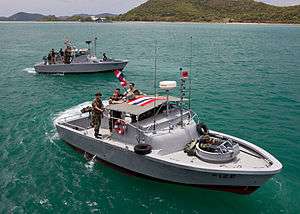
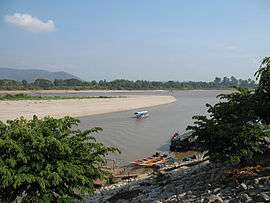
The Royal Thai Navy Riverine Patrol Regiment keeps the peace, prevents illegal immigration, human trafficking, drug smuggling or any other threats to national security on the Chao Phraya and Mekong Rivers and elsewhere.[27] Royal Thai Navy Riverine Patrol detachments are stationed in several provinces:
| Boat Station / Pier | District | Province | Department | ||
|---|---|---|---|---|---|
| Royal Thai Navy Riverine Patrol Regiment | |||||
| Riverine Patrol Regiment Pier | Bangkok Noi | Riverine Patrol Regiment | |||
| Chiang Saen Boat Station | Chiang Saen | Mekong Riverine Unit | |||
| Chiang Khong Boat Station | Chiang Khong | Mekong Riverine Unit | |||
| Chiang Khan Boat Station | Chiang Khan | Mekong Riverine Unit | |||
| Sangkhom Boat Station | Sangkhom | Mekong Riverine Unit | |||
| Nong Khai Boat Station | Mueang Nong Khai | Mekong Riverine Unit | |||
| Rattanawapi Boat Station | Rattanawapi | Mekong Riverine Unit | |||
| Phon Phisai Boat Station | Phon Phisai | Mekong Riverine Unit | |||
| Si Chiang Mai Boat Station | Si Chiang Mai | Mekong Riverine Unit | |||
| Bueng Kan Boat Station | Mueang Bueng Kan | Mekong Riverine Unit | |||
| Ban Phaeng Boat Station | Ban Phaeng | Mekong Riverine Unit | |||
| Nakhon Phanom Boat Station | Mueang Nakhon Phanom | Mekong Riverine Unit | |||
| That Phanom Boat Station | That Phanom | Mekong Riverine Unit | |||
| Mukdahan Boat Station | Mueang Mukdahan | Mekong Riverine Unit | |||
| Khemarat Boat Station | Khemarat | Mekong Riverine Unit | |||
| Khong Chiam Boat Station | Khong Chiam | Mekong Riverine Unit | |||
Royal Thai Naval Academy
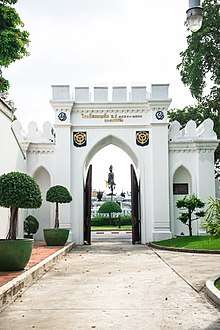
The Royal Thai Naval Academy in Samut Prakan was established by King Chulalongkorn (Rama V) in 1898,[28] Those who want to enter the academy first have to pass the entrance exam, after which they join a three-year preparatory program at the Armed Forces Academies Preparatory School where they study together with army, air force, and police cadets. On successful completion, they enter the Royal Thai Naval Academy. After graduation, they attend a further one-year advanced course at Sattahip that leads to a graduate diploma in naval science. On completion of this course, they are ready to work as officers in the Royal Thai Navy or Royal Thai Marine Corps. Cadets graduate with a bachelor's degree in engineering or science and are commissioned in the Royal Thai Navy with the rank of ensign (sub-lieutenant). Together with graduates of the other armed forces and police academies they receive their swords from the king personally or the king's representative. Selected first-year cadets of the RTNA are awarded scholarships to study at naval academies abroad. On their return to Thailand they start working as officers in the Royal Thai Navy straightaway.
Naval Medical Department
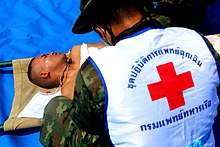
The Naval Medical Department was first set up on 1 April 1890 and is headquartered at Somdet Phra Pinklao Hospital in Bangkok. It provides medical services for sailors of the Royal Thai Navy and operates a number of hospitals in Thailand including Queen Sirikit Naval Hospital in Chonburi, opened on 20 November 1995.[29]
Royal Thai Navy Music Division
_band_plays_during_the_opening_ceremony_of_the_Thailand_phase_of_exercise_Cooperation_Afloat_Readiness_and_Training_(CARAT).jpg)
A Royal Thai Navy band has existed since the RTN was only a naval department of the Royal Thai Army. Its began with the creation of the "Naval Trumpet Band" on 10 June 1878, with the arrival of the new royal yacht Vesatri and her captain, M. Fusco, who later was one of the training instructors.
Captain Fusco had the duty to stage musicals for King Rama V when the king traveled by sea, as when King Chulalongkorn visited Europe in 1897. The government assigned the young ensemble under the command of Captain Fusco to the Royal Yacht Maha Chakri' for the voyage to Europe. This band would later become the basis of the Royal Thai Navy Music Division of the RTN Bangkok Naval Base. Today, the RTNMD stations bands in all naval bases and installations, as well as in educational institutions.
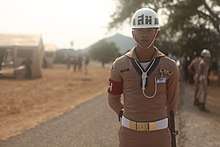
Naval Military Police Regiment
The navy was the first branch of the Thai military to create a military police unit. The naval military police was established at the order of Marshal Admiral Paribatra Sukhumbandhu, Prince of Nakhon Sawan, who was a naval commander at that time.[30] The official founding date was on 14 December 1905 by the Department of Mechanical Ships and the Department of Naval Affairs.[30]
Fleet
The Royal Thai Navy fleet consists of ships constructed in Canada, China, Germany, Italy, Singapore, South Korea, Spain, the United States, and the United Kingdom. Thai shipbuilding companies and RTN dockyards such as Mahidol Adulyadej Naval Dockyard, Asian Marine Services, Marsun Shipbuilding, Italthai Marine, and Bangkok Dock also have the capability to construct vessels.
Humanitarian relief operations
Thailand worked with more than 60 nations in providing help to the Nepali people following an earthquake. Operation Sahayogi Haat ('helping hands') was a US military relief operation delivering humanitarian assistance to victims of the April and May 2015 Nepal earthquakes. The Royal Thai Navy assisted relief efforts.[31] A magnitude 7.8 earthquake struck the region of Kathmandu in Nepal on 25 April 2015. Operation Sahayogi Haat for humanitarian relief operations was put into action by Joint Task Force 505 on 6 May 2015.[32][33]
Royal Barges
The royal barge is the type of vessel for Thailand's Royal Barge Procession, when is a ceremony of both religious and royal significance which has taken place for almost 700 years when was the earliest historical evidence of royal barges dates from the Sukhothai period (1238–1438).[34] The royal barges are a blend of craftsmanship and traditional Thai art. The Royal Barge Procession takes place rarely, marking only the most significant cultural and religious events.
Royal barge Narai Song Suban Ratchakan Thi Kao or the royal barge Narai Song Suban HM King Rama IX is the only barge out of four royal barges which was built under commission by the Royal Thai Navy, along with the Thai Department of Fine Arts.
She was built during the reign of HM King Rama IX Bhumibol Adulyadej, who laid the keel in 1994. Thus Narai Song Suban HM King Rama IX was launched on 6 May 1996 to be commissioned and coincide with the celebration of the 50 anniversary of Bhumibol Adulyadej's accession to the throne.
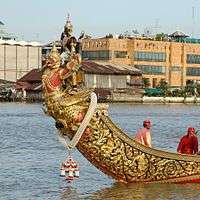 Royal Barge Narai Song Suban HM Rama IX of Thailand.
Royal Barge Narai Song Suban HM Rama IX of Thailand.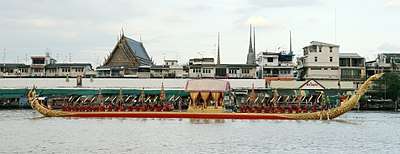 Royal Barge Narai Song Suban HM Rama IX of Thailand. Dress rehearsal on 29 October 2007 for 5 November 2007 Royal Barge Procession for Royal Kathin Ceremony at Wat Arun.
Royal Barge Narai Song Suban HM Rama IX of Thailand. Dress rehearsal on 29 October 2007 for 5 November 2007 Royal Barge Procession for Royal Kathin Ceremony at Wat Arun.
Historical engagements
|
|
Rank structure
| Equivalent NATO Code | OF-10 | OF-9 | OF-8 | OF-7 | OF-6 | OF-5 | OF-4 | OF-3 | OF-2 | OF-1 | Cadet Officer | |
|---|---|---|---|---|---|---|---|---|---|---|---|---|
| Officer ranks |
.svg.png) |
.svg.png) |
.svg.png) |
.svg.png) |
.svg.png) |
.svg.png) |
.svg.png) |
.svg.png) |
.svg.png) |
.svg.png) |
.svg.png) |
|
| จอมพลเรือ | พลเรือเอก | พลเรือโท | พลเรือตรี | พลเรือจัตวา1 | นาวาเอก | นาวาโท | นาวาตรี | เรือเอก | เรือโท | เรือตรี | นักเรียนนายเรือ | |
| Admiral of the Fleet | Admiral | Vice Admiral | Rear Admiral | Commodore or Rear Admiral (lower half)1 |
Captain | Commander | Lieutenant Commander | Lieutenant | Lieutenant Junior Grade |
Sub Lieutenant | Midshipman | |
| ||||||||||||
| Equivalent NATO Code | OR-9 | OR-8 | OR-7 | OR-5 | OR-4 | OR-3 | OR-1 | |
|---|---|---|---|---|---|---|---|---|
| Enlisted ranks |
.svg.png) |
.svg.png) |
.svg.png) |
.svg.png) |
.svg.png) |
.svg.png) |
.svg.png) |
No insignia |
| พันจ่าเอกพิเศษ | พันจ่าเอก | พันจ่าโท | พันจ่าตรี | จ่าเอก | จ่าโท | จ่าตรี | พลทหาร | |
| Master Chief Petty Officer |
Senior Chief Petty Officer |
Chief Petty Officer |
Petty Officer 1st class |
Petty Officer 2nd Class |
Petty Officer 3rd Class |
Seaman | Seaman apprentice | |
See also
- Admiral Prince Abhakara Kiartiwongse, Prince of Chumphon
- Royal Thai Armed Forces Headquarters
- Military of Thailand
- Royal Thai Army
- Royal Thai Air Force
- Royal Thai Marine Corps
- Royal Thai Naval Academy
References
Notes
Citations
- บำรุงสุข, สุรชาติ (18 July 2019). "เปิดข้อมูลอำนาจกำลังรบไทย". www.matichonweekly.com. Retrieved 17 November 2019.
- "Thailand's Budget in Brief Fiscal Year 2019". Bureau of the Budget. 20 December 2018. p. 84. Retrieved 3 December 2019.
- "Prawit defends army spending". Bangkok Post. 3 December 2019. Retrieved 3 December 2019.
- "History of Thailand". Nations Online. Retrieved 31 August 2012.
- Warington Smyth, H (1898). Five Years in Siam, from 1891 to 1896. v. 1. John Murray. ISBN 1375627406. Retrieved 30 August 2018.
- Tuck, Patrick (1995). The French Wolf and the Siamese Lamb; The French Threat to Siamese Independence 1858–1907 (1st ed.). White Lotus. ISBN 9789748496283.
- Stearn, Duncan (22 August 2009). "Thailand and the First World War". First World War.com. Retrieved 19 July 2015.
- Hart, Keith (1982). "A NOTE ON THE MILITARY PARTICIPATION OF SIAM IN WWI" (PDF). Journal of the Siam Society. Retrieved 19 July 2015.
- "90th Anniversary of World War I. This Is The History of Siamese Volunteer Corps". Thai Military Information Blog. Retrieved 3 December 2014.
- "70th Year of HTMS Thonburi Part II – The Fighting". ThaiArmedForce.com (in Thai). 17 January 2011. Retrieved 1 February 2013.
- WatcharaYui (4 March 2010). "Battle of Koh Chang overview". thaigunship.blogspot.com. Retrieved 1 February 2013.
- Brecher & Wilkenfeld 1997, p. 407.
- Reynolds, Thailand's Secret War, 304–05 with photograph on 306.
- Fuangrabil, Krisda (May 2007). "สู่วาระสุดท้ายของเรือหลวงศรีอยุธยา: ทหารเรือกับเหตุสำคัญของบ้านเมืองในอดีต (ตอนที่ 4)" (PDF). Nawikasat. 90 (5): 6–14.
- Malcolm H. Murfett (2012). Cold War Southeast Asia. Marshall Cavendish International Asia Pte Ltd. p. 166. ISBN 978-981-4382-98-4.
- "Museum". Thai Seafarer. 26 September 2019. Retrieved 5 December 2019.
- Conboy 1991, p. 52.
- "หน่วยรบพิเศษ SPECIAL FORCE: กองพันลาดตระเวน (recon) รีคอน" (in Thai). Archived from the original on 12 February 2019. Retrieved 11 February 2019.
- "ด่านศุลกากรนครศรีธรรมราช - Nakhonsithammarat Customs House". nakhonsithammarat.customs.go.th (in Thai). Archived from the original on 12 February 2019. Retrieved 11 February 2019.
- "ฝึกโหด โคตรภูมิใจ! เปิดใจนักรบรีคอน เรียนเกือบตาย ได้เอาไปใช้จริงไหม". Archived from the original on 26 December 2017. Retrieved 17 February 2019.
- "นักรบรีคอน ...ยอดคนแกร่ง นักรบเ". Archived from the original on 5 June 2013. Retrieved 17 February 2019.
- Jomyut, Baan (28 March 2018). "การปรับตัวของไทยในยุคสงครามเย็น". www.baanjomyut.com. Retrieved 22 October 2018.
- "Rescuer dies during dive in flooded Tham Luang cave". Bangkok Post. 6 July 2018. Retrieved 5 December 2019.
- John Pike. "Air and Coastal Defense Command". Archived from the original on 24 December 2014. Retrieved 24 December 2014.
- "World Air Forces 2018" (PDF). Flight International. 28 March 2018. p. 31. Retrieved 5 December 2019.
- "The Royal Thai Navy (RTN) received six Special Operations Craft – Riverine (SOC-R)". Thai Military and Asian Region. 28 March 2016. Retrieved 5 December 2019.
- "Royal Thai Naval Academy". RTNA. Retrieved 1 December 2008.
- "ความเป็นมาโรงพยาบาล".
- ทร. สถาปนากรมกรมสารวัตรทหารเรือ ครบ 111 ปี - ข่าวสด
- Martinez, Staff Sgt. Alexander (29 May 2015). "Thai and USA forces combine to help earthquake victims in Nepal". Pattaya Mail. Archived from the original on 1 June 2015. Retrieved 31 May 2015.
- "Operation Sahayogi Haat / Helping Hand". Global Security. Archived from the original on 1 June 2015. Retrieved 31 May 2015.
- "Nepal Earthquake Relief Effort Named 'Operation Sahayogi Haat'". Nepal Foreign Affairs. 10 May 2015. Archived from the original on 25 May 2015. Retrieved 31 May 2015.
- royal, finearts (26 September 2019). "Royal Barge Procession". www.moe.go.th. Retrieved 6 October 2019.
Bibliography
- Mach, Andrzej (1988). "Re: The Royal Thai Navy". Warship International. XXV (3): 226–227. ISSN 0043-0374.
- Mach, Andrzej (1988). "Re: The Thai Navy". Warship International. XXV (2): 113–116. ISSN 0043-0374.
- Roberts, Stephen S. (1986). "The Thai Navy". Warship International. XXIII (3): 217–265. ISSN 0043-0374.
- Ruth, Richard A. "Prince Abhakara’s Experiences with Britain’s Royal Navy: Education, Geopolitical Rivalries and the Role of a Cretan Adventure in Apotheosis". Sojourn: Journal of Social Issues in Southeast Asia, vol. 34, no. 1, 2019, pp. 1–47. JSTOR, www.jstor.org/stable/26594523.ISSN 0217-9520
External links
| Wikimedia Commons has media related to Royal Thai Navy. |
- Official site (in Thai)
- Global Security – Thailand navy
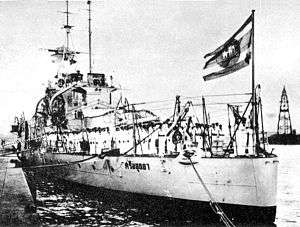
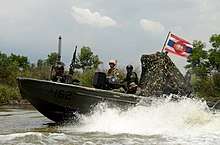
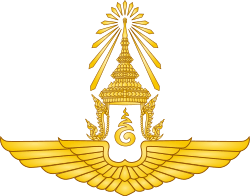
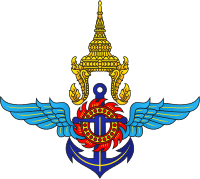
.svg.png)